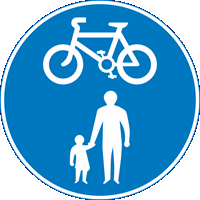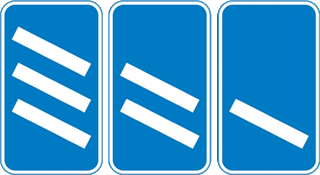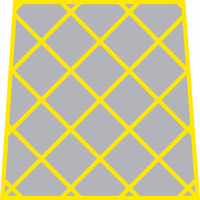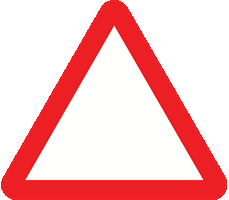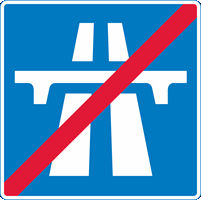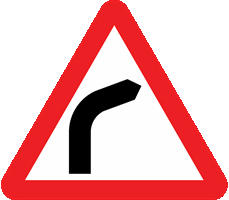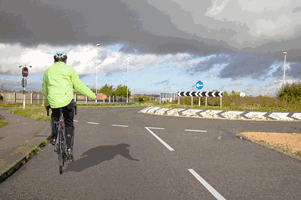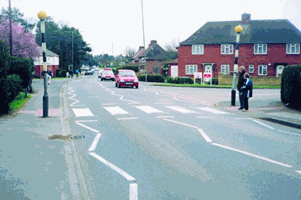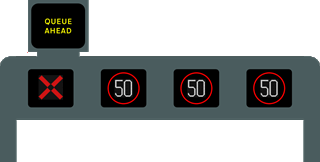This free driving theory practice test consists of 50 questions.
You need 43 out of 50 (86%) to pass. You have a time limit of 57 minutes.
Read more about the theory test and how it works.
There are no tests related to this category :
There are no tests related to this category :
Quick view of test questions. Click question box to reveal correct answer.
Correct Answer: A
Explanation: To prevent braking and steering problems from developing, you should ensure your tyres are free from defects. They should be sufficiently inflated and have optimum tread depth and tyre pressure. This provides for a safer, more comfortable driving experience as well as reducing the risk of skidding.
Explanation: To prevent braking and steering problems from developing, you should ensure your tyres are free from defects. They should be sufficiently inflated and have optimum tread depth and tyre pressure. This provides for a safer, more comfortable driving experience as well as reducing the risk of skidding.
Correct Answer: C
Explanation: Red routes enforce strict parking regulations, and help reduce congestion by preventing inconsiderate parking. Keeping traffic flowing helps reduce exhaust emissions and fuel consumption, both of which are worsened by slow driving and stop-starting.
Explanation: Red routes enforce strict parking regulations, and help reduce congestion by preventing inconsiderate parking. Keeping traffic flowing helps reduce exhaust emissions and fuel consumption, both of which are worsened by slow driving and stop-starting.
Correct Answer: A
Explanation: This sign indicates that there's a shared route for both cyclists and pedestrians nearby. Be aware that cyclists will re-join the main road when the route ends.
Explanation: This sign indicates that there's a shared route for both cyclists and pedestrians nearby. Be aware that cyclists will re-join the main road when the route ends.
A
B
C
D
B
C
D
Correct Answer: A
Explanation: You should give a cyclist turning right at a roundabout plenty of time and space to get into the correct lane.
Explanation: You should give a cyclist turning right at a roundabout plenty of time and space to get into the correct lane.
Correct Answer: C
Explanation: These are countdown markers indicating an upcoming motorway exit. You'll find them positioned 90 metres apart, starting 270 metres from the slip road. If you're planning to take the indicated exit, move into the left-hand lane well before reaching the slip road.
Explanation: These are countdown markers indicating an upcoming motorway exit. You'll find them positioned 90 metres apart, starting 270 metres from the slip road. If you're planning to take the indicated exit, move into the left-hand lane well before reaching the slip road.
Correct Answer: A
Explanation: Unless otherwise stated, any road with street lights has a 30 mph speed limit.
Explanation: Unless otherwise stated, any road with street lights has a 30 mph speed limit.
Correct Answer: D
Explanation: Clearways are designed to keep traffic flowing. You shouldn't ever park on a clearway, as even a single parked vehicle can have a ripple effect, slowing traffic. The 'no parking' rule also extends to stopping to collect or drop off passengers.
Explanation: Clearways are designed to keep traffic flowing. You shouldn't ever park on a clearway, as even a single parked vehicle can have a ripple effect, slowing traffic. The 'no parking' rule also extends to stopping to collect or drop off passengers.
Correct Answer: B
Explanation: In most scenarios, you shouldn't enter a yellow box junction if your exit isn't clear. The one exception to this is if you're turning right but your way is blocked by oncoming traffic or other vehicles turning right. Yellow box junctions are designed to keep traffic flowing through the junction at busy times.
Explanation: In most scenarios, you shouldn't enter a yellow box junction if your exit isn't clear. The one exception to this is if you're turning right but your way is blocked by oncoming traffic or other vehicles turning right. Yellow box junctions are designed to keep traffic flowing through the junction at busy times.
Correct Answer: A
Explanation: Many places with abundant vulnerable road users (near parks, schools, and residential areas, for example) combine low speed limits with traffic-calming measures, such as speed humps. They're designed to slow traffic down, improving safety for pedestrians. If you see these measures in place, slow down.
Explanation: Many places with abundant vulnerable road users (near parks, schools, and residential areas, for example) combine low speed limits with traffic-calming measures, such as speed humps. They're designed to slow traffic down, improving safety for pedestrians. If you see these measures in place, slow down.
Correct Answer: D
Explanation: Triangular signs warn of upcoming hazards. To ensure you don't miss important information, pay attention to every sign you pass.
Explanation: Triangular signs warn of upcoming hazards. To ensure you don't miss important information, pay attention to every sign you pass.
11. You're approaching this junction. You see a 'stop' sign accompanied by a solid white line on the road. Why are you being instructed to stop?
Mark one answer
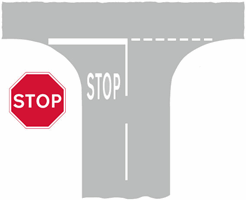
B
C
D
Correct Answer: D
Explanation: The solid white line tells you to stop. This instruction is given because the view onto the main road is restricted. You might also see a stop sign. Don't pull out until you're sure it is safe to do so.
Explanation: The solid white line tells you to stop. This instruction is given because the view onto the main road is restricted. You might also see a stop sign. Don't pull out until you're sure it is safe to do so.
A
B
C
D
B
C
D
Correct Answer: B
Explanation: Police officers wanting you to stop will flash their lights, indicate left, and point left to get you to pull over. It is mandatory to obey signals from police officers.
Explanation: Police officers wanting you to stop will flash their lights, indicate left, and point left to get you to pull over. It is mandatory to obey signals from police officers.
Correct Answer: A
Explanation: This sign warns that the lane below is closing and you should move to the lane to the left. Signs above motorway lanes can warn of temporary speed limits, adverse weather ahead, and lane closures.
Explanation: This sign warns that the lane below is closing and you should move to the lane to the left. Signs above motorway lanes can warn of temporary speed limits, adverse weather ahead, and lane closures.
Correct Answer: B
Explanation: This sign indicates that the motorway ends ahead. Check your speed and look for speed limit signs, as the speed allowed following the end of the motorway may be different.
Explanation: This sign indicates that the motorway ends ahead. Check your speed and look for speed limit signs, as the speed allowed following the end of the motorway may be different.
Correct Answer: D
Explanation: Traffic-calming measures are intended to slow traffic and make the road safer for vulnerable road users, like pedestrians, children, and cyclists. Speed humps, chicanes, and narrowings are all forms of traffic-calming measures.
Explanation: Traffic-calming measures are intended to slow traffic and make the road safer for vulnerable road users, like pedestrians, children, and cyclists. Speed humps, chicanes, and narrowings are all forms of traffic-calming measures.
Correct Answer: A
Explanation: Keeping these road markings clear ensures there's always a good view of the crossing area. This allows approaching drivers to see if pedestrians and children are about to cross, and lets pedestrians and children see approaching traffic.
Explanation: Keeping these road markings clear ensures there's always a good view of the crossing area. This allows approaching drivers to see if pedestrians and children are about to cross, and lets pedestrians and children see approaching traffic.
17. You are turning right in busy traffic. You're already indicating. What could you do to confirm your intention?
Mark one answer
AB
C
D
Correct Answer: B
Explanation: You might choose to signal with your arm if you suspect other road users can't see your indicators properly. Learn the arm signals shown in The Highway Code, so you know which to use at any given time.
Explanation: You might choose to signal with your arm if you suspect other road users can't see your indicators properly. Learn the arm signals shown in The Highway Code, so you know which to use at any given time.
Correct Answer: C
Explanation: Keeping left as you approach a right-hand bend will give you a clearer, earlier look at the road around the corner. You'll be able to see any potential hazards sooner. Additionally, risk of collision with oncoming vehicles that have strayed over the centre line is reduced.
Explanation: Keeping left as you approach a right-hand bend will give you a clearer, earlier look at the road around the corner. You'll be able to see any potential hazards sooner. Additionally, risk of collision with oncoming vehicles that have strayed over the centre line is reduced.
Correct Answer: C
Explanation: You should be cautious at unmarked junctions, especially where obstructions - such as hedges, parked cars, and buildings - block your view. In summer months, foliage may have grown to obstruct your view further, so take extra care.
Explanation: You should be cautious at unmarked junctions, especially where obstructions - such as hedges, parked cars, and buildings - block your view. In summer months, foliage may have grown to obstruct your view further, so take extra care.
20. What should the driver of the red car do upon seeing the pedestrian crossing the road?
Mark one answer
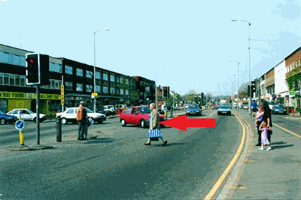
B
C
D
Correct Answer: B
Explanation: It's not uncommon for older pedestrians or those with disabilities to take longer crossing the road. If you encounter a situation like this, you should slow down or stop to allow them to finish crossing. Remain calm and don't show any impatience. Additionally, don't signal for any waiting pedestrians to cross, as this could create potentially hazardous situations where other drivers haven't seen your signal and don't notice the pedestrian.
Explanation: It's not uncommon for older pedestrians or those with disabilities to take longer crossing the road. If you encounter a situation like this, you should slow down or stop to allow them to finish crossing. Remain calm and don't show any impatience. Additionally, don't signal for any waiting pedestrians to cross, as this could create potentially hazardous situations where other drivers haven't seen your signal and don't notice the pedestrian.
Correct Answer: D
Explanation: You must use parking lights if parking on a road with a speed limit greater than 30 mph. Additionally, you should park facing the same way as passing traffic, so they'll be able to see your rear reflectors as they approach.
Explanation: You must use parking lights if parking on a road with a speed limit greater than 30 mph. Additionally, you should park facing the same way as passing traffic, so they'll be able to see your rear reflectors as they approach.
Correct Answer: C
Explanation: Infra-red sensors at Puffin crossings detect when pedestrians are still crossing, and keep the red light showing until they've crossed. There is no flashing amber phase at puffin crossings, setting them apart from pelican crossings.
Explanation: Infra-red sensors at Puffin crossings detect when pedestrians are still crossing, and keep the red light showing until they've crossed. There is no flashing amber phase at puffin crossings, setting them apart from pelican crossings.
23. While driving, you often see place names painted directly onto the road surface. Why is this?
Mark one answer
AB
C
D
Correct Answer: A
Explanation: These words indicate the destinations possible from each lane, letting you know which lane you should be in. They're more common in towns and cities at busy junctions and complex road systems.
Explanation: These words indicate the destinations possible from each lane, letting you know which lane you should be in. They're more common in towns and cities at busy junctions and complex road systems.
24. You are in the left lane of a motorway. How should you react to traffic joining from the left?
Mark one answer
AB
C
D
Correct Answer: B
Explanation: Have joining traffic in mind whenever you're on the motorway approaching a slip road. If it is safe to do so, move into the next lane on the right, making more space in the left-hand lane. This makes it easier for others to join the motorway.
Explanation: Have joining traffic in mind whenever you're on the motorway approaching a slip road. If it is safe to do so, move into the next lane on the right, making more space in the left-hand lane. This makes it easier for others to join the motorway.
Correct Answer: B
Explanation: This sign warns of two-way traffic crossing a one-way street. Look both ways as you navigate the junction, as traffic could be coming from either direction.
Explanation: This sign warns of two-way traffic crossing a one-way street. Look both ways as you navigate the junction, as traffic could be coming from either direction.
Correct Answer: C
Explanation: Even a well-planned route can fall foul of unexpected roadworks. Take care to plan alternative routes when planning your journey. Doing so will result in a less stressful drive. If planning to use the motorway, make your alternative route use non-motorway roads, and always have a map in the car just in case.
Explanation: Even a well-planned route can fall foul of unexpected roadworks. Take care to plan alternative routes when planning your journey. Doing so will result in a less stressful drive. If planning to use the motorway, make your alternative route use non-motorway roads, and always have a map in the car just in case.
Correct Answer: A
Explanation: Cyclists and motorcyclists often steer around drain covers in the wet because they prevent a skid risk, and could cause them to lose their balance or even fall. Watch for these hazards as you drive, and learn to anticipate the actions required of different vehicles in different conditions. Cyclists and motorcyclists are also warier of potholes, and will move to avoid them.
Explanation: Cyclists and motorcyclists often steer around drain covers in the wet because they prevent a skid risk, and could cause them to lose their balance or even fall. Watch for these hazards as you drive, and learn to anticipate the actions required of different vehicles in different conditions. Cyclists and motorcyclists are also warier of potholes, and will move to avoid them.
28. On a single carriageway, what is the national speed limit for motorcycles and cars?
Mark one answer
AB
C
D
Correct Answer: C
Explanation: The national speed limit for cars and motorcycles on single carriageways is 60 mph. National speed limits vary by vehicle and road type, and you should know the limit for the vehicles and roads you use. Breaking the speed limit - as well as being dangerous - can result in you receiving penalty points, a fine, or even losing your licence.
Explanation: The national speed limit for cars and motorcycles on single carriageways is 60 mph. National speed limits vary by vehicle and road type, and you should know the limit for the vehicles and roads you use. Breaking the speed limit - as well as being dangerous - can result in you receiving penalty points, a fine, or even losing your licence.
A
B
C
D
B
C
D
Correct Answer: D
Explanation: Keeping the details on your vehicle registration certificate (V5C) up to date is your responsibility, and you need to inform the DVLA of any changes. Failing to do this might make selling your vehicle difficult. Details on the V5C include your name, address, and vehicle details.
Explanation: Keeping the details on your vehicle registration certificate (V5C) up to date is your responsibility, and you need to inform the DVLA of any changes. Failing to do this might make selling your vehicle difficult. Details on the V5C include your name, address, and vehicle details.
Correct Answer: A
Explanation: Due to their more vulnerable status, some cyclists might be more comfortable staying in the left lane instead of cutting across into the right lane to turn right, or they might have been blocked from doing so by heavy traffic. Be aware of this and know that the cyclist could turn right from the left lane. Give them plenty of space.
Explanation: Due to their more vulnerable status, some cyclists might be more comfortable staying in the left lane instead of cutting across into the right lane to turn right, or they might have been blocked from doing so by heavy traffic. Be aware of this and know that the cyclist could turn right from the left lane. Give them plenty of space.
Correct Answer: B
Explanation: You should prepare to slow down and stop as you near this junction, especially if people are walking nearby. You shouldn't wave waiting pedestrians across, as an approaching vehicle in the other direction could present a danger.
Explanation: You should prepare to slow down and stop as you near this junction, especially if people are walking nearby. You shouldn't wave waiting pedestrians across, as an approaching vehicle in the other direction could present a danger.
Correct Answer: C
Explanation: These signs indicate that the normal running lanes have a compulsory speed limit of 50 mph, and that the hard shoulder is currently only available for use in breakdowns and emergencies. The hard shoulder will sometimes be used as a running lane on smart motorways; if so, it will have a compulsory speed limit shown above it.
Explanation: These signs indicate that the normal running lanes have a compulsory speed limit of 50 mph, and that the hard shoulder is currently only available for use in breakdowns and emergencies. The hard shoulder will sometimes be used as a running lane on smart motorways; if so, it will have a compulsory speed limit shown above it.
A
B
C
D
B
C
D
Correct Answer: C
Explanation: Shock can be tricky to diagnose following a collision. Look out for pale, grey skin, sweating, a rapid pulse, and rapid, shallow breathing.
Explanation: Shock can be tricky to diagnose following a collision. Look out for pale, grey skin, sweating, a rapid pulse, and rapid, shallow breathing.
Correct Answer: C
Explanation: The typical braking distance is the distance required to brake to a stop from a given speed. In reality, you'll also need time to think. Thinking distance plus braking distance is referred to as 'overall stopping distance'. At 50 mph, braking distance is 38 metres and thinking distance is 15 metres, giving a total of 53 metres. This will also be affected by how much attention you're paying, the nature of hazards ahead, and road conditions.
Explanation: The typical braking distance is the distance required to brake to a stop from a given speed. In reality, you'll also need time to think. Thinking distance plus braking distance is referred to as 'overall stopping distance'. At 50 mph, braking distance is 38 metres and thinking distance is 15 metres, giving a total of 53 metres. This will also be affected by how much attention you're paying, the nature of hazards ahead, and road conditions.
Correct Answer: C
Explanation: You should slow down ahead of sheep in the road and pass very slowly. They're easily spooked if vehicles get too close. They should be accompanied by a farmer, and you should obey the farmer's signals to make passing as safe as possible.
Explanation: You should slow down ahead of sheep in the road and pass very slowly. They're easily spooked if vehicles get too close. They should be accompanied by a farmer, and you should obey the farmer's signals to make passing as safe as possible.
36. As well as having your fog lights on, what can you do to reduce the risk of an accident while following a vehicle through fog?
Mark one answer
AB
C
D
Correct Answer: A
Explanation: When driving with poor visibility, you should increase the gap between you and the vehicle in front as well as using your fog lights. This and maintaining a sensible speed will ensure you have time to brake safely if a hazard presents itself. Allow double the normal stopping distance in wet weather, and ten times the normal stopping distance in icy conditions.
Explanation: When driving with poor visibility, you should increase the gap between you and the vehicle in front as well as using your fog lights. This and maintaining a sensible speed will ensure you have time to brake safely if a hazard presents itself. Allow double the normal stopping distance in wet weather, and ten times the normal stopping distance in icy conditions.
Correct Answer: D
Explanation: Animals are unpredictable. If startled, they could run into your path or the path of another vehicle. You should stop and turn off your engine if someone in charge of animals asks you to do so.
Explanation: Animals are unpredictable. If startled, they could run into your path or the path of another vehicle. You should stop and turn off your engine if someone in charge of animals asks you to do so.
38. You're about to reverse into a side road, but you can't tell if the area is clear. What should you do next?
Mark one answer
AB
C
D
Correct Answer: D
Explanation: The best way to check the coast is clear in this scenario is to leave your vehicle and check. There could be small children, low obstructions, or people using mobility scooters behind your vehicle.
Explanation: The best way to check the coast is clear in this scenario is to leave your vehicle and check. There could be small children, low obstructions, or people using mobility scooters behind your vehicle.
Correct Answer: A
Explanation: Keep to the left as you approach the junction, as you position on the road can help others determine what you're about to do. You shouldn't swing out into the centre of the road when making the turn, as this might mislead other traffic as to your intentions, and engager oncoming traffic.
Explanation: Keep to the left as you approach the junction, as you position on the road can help others determine what you're about to do. You shouldn't swing out into the centre of the road when making the turn, as this might mislead other traffic as to your intentions, and engager oncoming traffic.
40. You are parking your car but are unsure whether it is safe to reverse. What should you do?
Mark one answer
AB
C
D
Correct Answer: A
Explanation: If you're unsure whether it's safe to reverse, get out of your car to check. Small children or those using mobility scooters may not be visible in your mirrors. Another option is to ask a reliable person to look what's behind and guide your manoeuvre.
Explanation: If you're unsure whether it's safe to reverse, get out of your car to check. Small children or those using mobility scooters may not be visible in your mirrors. Another option is to ask a reliable person to look what's behind and guide your manoeuvre.
Correct Answer: B
Explanation: You should never reverse from a side road onto a main road. Traffic on a main road moves quickly, and there is increased likelihood of collision.
Explanation: You should never reverse from a side road onto a main road. Traffic on a main road moves quickly, and there is increased likelihood of collision.
Correct Answer: B
Explanation: If you have one, a garage is the safest place to keep your car. This will protect your car from both potential thieves and the elements.
Explanation: If you have one, a garage is the safest place to keep your car. This will protect your car from both potential thieves and the elements.
Correct Answer: D
Explanation: MOT exhaust emissions tests measure the level of pollution produced by your engine. If your vehicle isn't serviced regularly, the engine may not be operating efficiently and could have high levels of emissions. It may fail its MOT.
Explanation: MOT exhaust emissions tests measure the level of pollution produced by your engine. If your vehicle isn't serviced regularly, the engine may not be operating efficiently and could have high levels of emissions. It may fail its MOT.
Correct Answer: C
Explanation: Anti-lock brakes are most effective when you're braking hard to stop quickly. You should keep your foot pressed firmly on the brake until you come to a stop. It's normal to hear a grating sound and feel vibration through the pedal as you press down.
Explanation: Anti-lock brakes are most effective when you're braking hard to stop quickly. You should keep your foot pressed firmly on the brake until you come to a stop. It's normal to hear a grating sound and feel vibration through the pedal as you press down.
Correct Answer: D
Explanation: While the 'two-second rule' is useful in dry, good conditions, it should be increased to four seconds in wet weather. Stay back from the lorry to give yourself a good view of the road ahead and avoid the worst of the spray. You'll also be more visible in the lorry's mirrors, and will have more time to brake if needed.
Explanation: While the 'two-second rule' is useful in dry, good conditions, it should be increased to four seconds in wet weather. Stay back from the lorry to give yourself a good view of the road ahead and avoid the worst of the spray. You'll also be more visible in the lorry's mirrors, and will have more time to brake if needed.
Correct Answer: D
Explanation: Coasting (staying in neutral or keeping the clutch depressed) downhill will cause your vehicle to pick up speed. There will be no engine braking and you'll suffer a loss of control. Don't coast, particularly when approaching bends, junctions, or downhill sections of road.
Explanation: Coasting (staying in neutral or keeping the clutch depressed) downhill will cause your vehicle to pick up speed. There will be no engine braking and you'll suffer a loss of control. Don't coast, particularly when approaching bends, junctions, or downhill sections of road.
47. What should you do if your car catches fire in a tunnel, but is still driveable?
Mark one answer
AB
C
D
Correct Answer: A
Explanation: If it's possible to continue on without causing further danger, you should continue to drive out of the tunnel. Smoke gathers in tunnels, presenting risk of suffocation.
Explanation: If it's possible to continue on without causing further danger, you should continue to drive out of the tunnel. Smoke gathers in tunnels, presenting risk of suffocation.
48. What should you do if ill health impacts your driving after you've passed your practical exam?
Mark one answer
AB
C
D
Correct Answer: C
Explanation: If your health deteriorates and affects your ability to drive, you need to inform the DVLA (or DVA in Northern Ireland). After looking into your condition and situation, they will decide whether you are allowed to keep your licence.
Explanation: If your health deteriorates and affects your ability to drive, you need to inform the DVLA (or DVA in Northern Ireland). After looking into your condition and situation, they will decide whether you are allowed to keep your licence.
Correct Answer: B
Explanation: You need to find a safe place to rest. Usually, this will be the next services, but if there are no services coming up, take the next exit and find a safe, legal place to stop. The hard shoulder should never be used for resting.
Explanation: You need to find a safe place to rest. Usually, this will be the next services, but if there are no services coming up, take the next exit and find a safe, legal place to stop. The hard shoulder should never be used for resting.
Correct Answer: A
Explanation: Only in genuine emergencies is it permitted to stop on the hard shoulder. It should not be used for resting, answering or making a phone call, checking a map, or picking up a passenger. In the event you miss your exit, continue to the next one; under no circumstances should you reverse on the motorway.
Explanation: Only in genuine emergencies is it permitted to stop on the hard shoulder. It should not be used for resting, answering or making a phone call, checking a map, or picking up a passenger. In the event you miss your exit, continue to the next one; under no circumstances should you reverse on the motorway.


